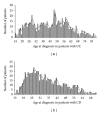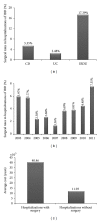Trends and Factors Affecting Hospitalization Costs in Patients with Inflammatory Bowel Disease: A Two-Center Study over the Past Decade
- PMID: 24307891
- PMCID: PMC3838837
- DOI: 10.1155/2013/267630
Trends and Factors Affecting Hospitalization Costs in Patients with Inflammatory Bowel Disease: A Two-Center Study over the Past Decade
Abstract
With the growing number of patients with inflammatory bowel disease (IBD) and hospitalization cases, the overall medical care cost elevates significantly in consequence. A total of 2458 hospitalizations, involving 1401 patients with IBD, were included from two large medical centers. Hospitalization costs and factors impacting cost changes were determined. Patients with IBD and frequency of hospitalizations increased significantly from 2003 to 2011 (P < 0.001). The annual hospitalization cost per patient, cost per hospitalization, and daily cost during hospitalization increased significantly in the past decade (all P < 0.001). However, length of stay decreased significantly (P < 0.001). Infliximab was the most significant factor associated with higher hospitalization cost (OR = 44380.09, P < 0.001). Length of stay (OR = 1.29, P < 0.001), no medical insurance (OR = 1.31, P = 0.017), CD (OR = 3.55, P < 0.001), inflammatory bowel disease unclassified (IBDU) (OR = 4.30, P < 0.0001), poor prognosis (OR = 6.78, P < 0.001), surgery (OR = 3.16, P < 0.001), and endoscopy (OR = 2.44, P < 0.001) were found to be predictors of higher hospitalization costs. Patients with IBD and frequency of hospitalizations increased over the past decade. CD patients displayed a special one peak for age at diagnosis, which was different from UC patients. The increased hospitalization costs of IBD patients may be associated with infliximab, length of stay, medical insurance, subtypes of IBD, prognosis, surgery, and endoscopy.
Figures







References
-
- Molodecky NA, Soon IS, Rabi DM, et al. Increasing incidence and prevalence of the inflammatory bowel diseases with time, based on systematic review. Gastroenterology. 2012;142(1):46–54. - PubMed
-
- Lovasz BD, Golovics PA, Vegh Z, Lakatos PL. New trends in inflammatory bowel disease epidemiology and disease course in Eastern Europe. Digestive and Liver Disease. 2013;45(4):269–276. - PubMed
LinkOut - more resources
Full Text Sources
Other Literature Sources
Miscellaneous

